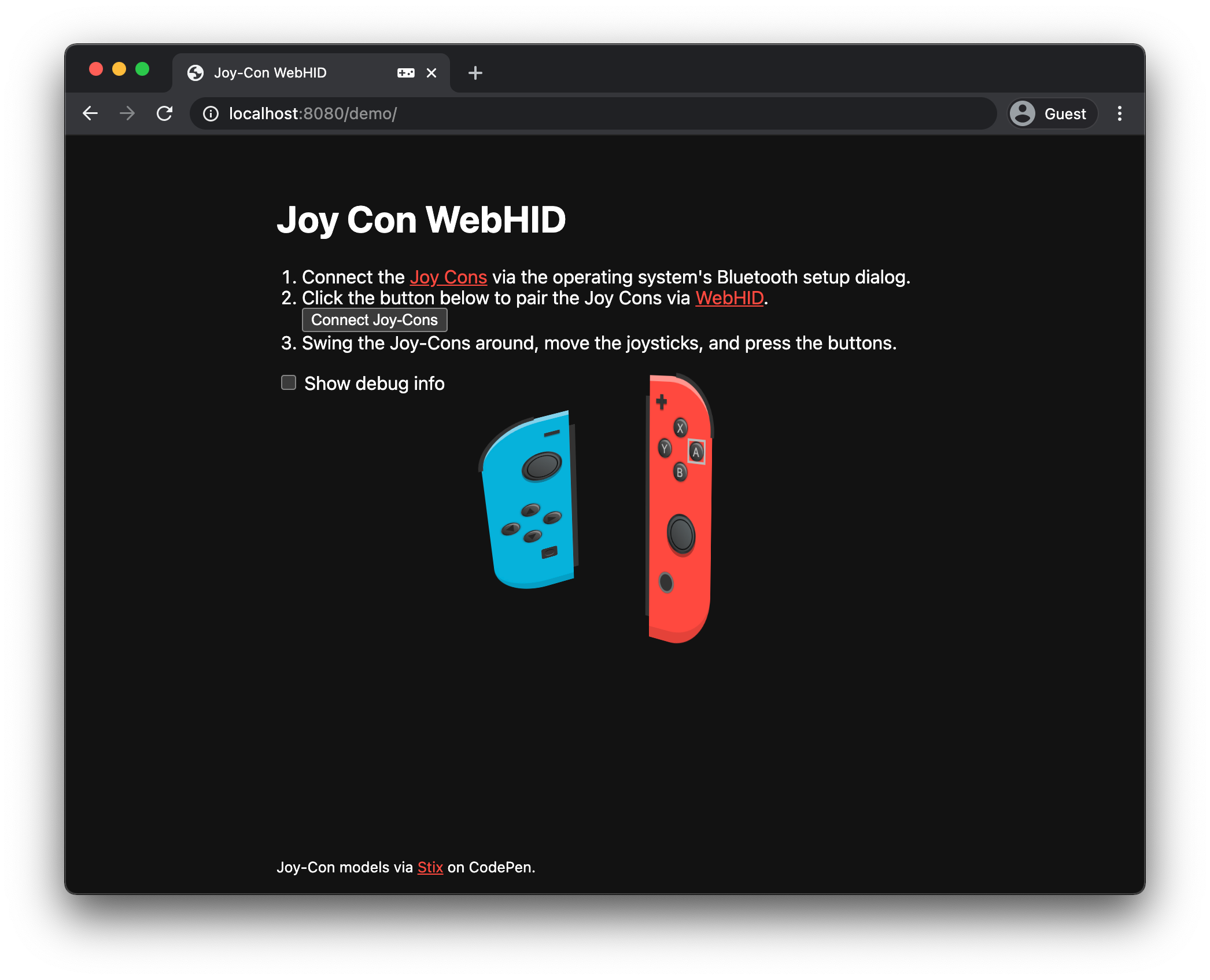
Security News
PEP 810 Proposes Explicit Lazy Imports for Python 3.15
An opt-in lazy import keyword aims to speed up Python startups, especially CLIs, without the ecosystem-wide risks that sank PEP 690.
joy-con-webhid
Advanced tools
A WebHID driver for Nintendo Joy-Cons with support for all buttons, analog sticks, all LEDs, and the device's gyroscope and accelerometer sensors.
See the live demo of the driver.

Another demo is Chrome Dino WebHID, where you can play the Chrome dino game 🦖 over WebHID by jumping with a Joy-Con controller in your pocket.
Yet another demo courtesy of @light2peter is the Web MIDI demo, where the Joy-Cons are being used to make music on Web MIDI receivers.
npm install --save joy-con-webhid
(For Linux, see this comment on Issue #3 for required pre-steps.)
Make sure you have a pairing button on your page.
<button class="connect" type="button">Connect Joy-Con</button>
Import the script and hook up the pairing button. Then create an interval that waits for Joy-Cons to appear, which can happen after pairing, on page load when previously paired Joy-Cons are reconnected, and when Joy-Cons wake up again after being idle.
import * as JoyCon from './node_modules/dist/index.js';
// For the initial pairing of the Joy-Cons. They need to be paired one by one.
// Once paired, Joy-Cons will be reconnected to on future page loads.
document.querySelector('.connect').addEventListener('click', async () => {
// `JoyCon.connectJoyCon()` handles the initial HID pairing.
// It keeps track of connected Joy-Cons in the `JoyCon.connectedJoyCons` Map.
await JoyCon.connectJoyCon();
});
// Joy-Cons may sleep until touched and fall asleep again if idle, so attach
// the listener dynamically, but only once.
setInterval(async () => {
for (const joyCon of JoyCon.connectedJoyCons.values()) {
if (joyCon.eventListenerAttached) {
continue;
}
// Open the device and enable standard full mode and inertial measurement
// unit mode, so the Joy-Con activates the gyroscope and accelerometers.
await joyCon.open();
await joyCon.enableStandardFullMode();
await joyCon.enableIMUMode();
await joyCon.enableVibration();
// Get information about the connected Joy-Con.
console.log(await joyCon.getDeviceInfo());
// Rumble.
await joyCon.rumble(600, 600, 0.5);
// Turn On and Off the Home LED 3 times
await joyCon.setHomeLEDPattern(2, 3, 0, [
{ intensity: 0, fadeDuration: 10, duration: 5 },
{ intensity: 15, fadeDuration: 10, duration: 5 },
{ intensity: 0, fadeDuration: 10, duration: 5 },
]);
// Listen for HID input reports.
joyCon.addEventListener('hidinput', ({ detail }) => {
// Careful, this fires at ~60fps.
console.log(`Input report from ${joyCon.device.productName}:`, detail);
});
joyCon.eventListenerAttached = true;
}
}, 2000);
The Gamepad API supports Joy-Con controllers out-of-the-box, but since the API (currently) does not have a concept of orientation, the Joy-Cons' accelerometer and gyroscope data cannot be accessed. The buttons and analog sticks are fully exposed, though. If all you need is this, then by all means go for the Gamepad API.
This project takes heavy inspiration from @wazho's ns-joycon, which in turn is based on @dekuNukem's Nintendo_Switch_Reverse_Engineering. The rumble code was contributed by @baku89. The HVC-Controller code was added by @taisukef. The Ring-Con code from @mascii. TypeScript support was added by @andrewgremlich.
Apache 2.0.
FAQs
Joy-Con over WebHID
We found that joy-con-webhid demonstrated a healthy version release cadence and project activity because the last version was released less than a year ago. It has 1 open source maintainer collaborating on the project.
Did you know?

Socket for GitHub automatically highlights issues in each pull request and monitors the health of all your open source dependencies. Discover the contents of your packages and block harmful activity before you install or update your dependencies.

Security News
An opt-in lazy import keyword aims to speed up Python startups, especially CLIs, without the ecosystem-wide risks that sank PEP 690.

Security News
Socket CEO Feross Aboukhadijeh discusses the recent npm supply chain attacks on PodRocket, covering novel attack vectors and how developers can protect themselves.

Security News
Maintainers back GitHub’s npm security overhaul but raise concerns about CI/CD workflows, enterprise support, and token management.